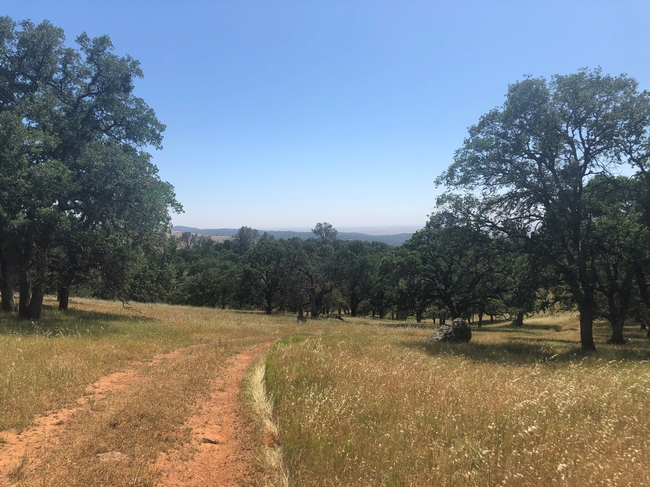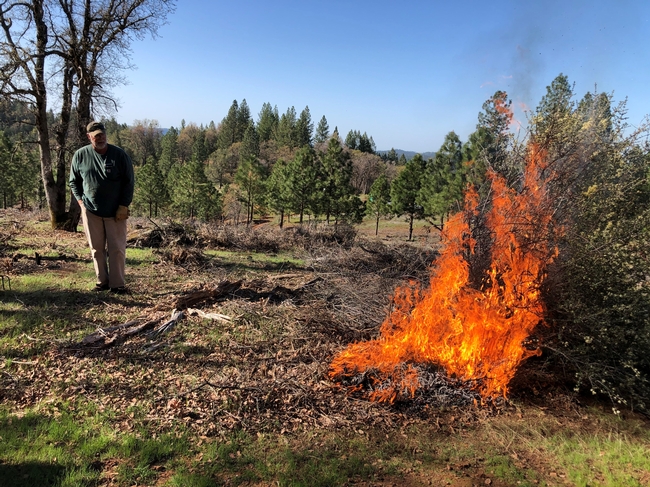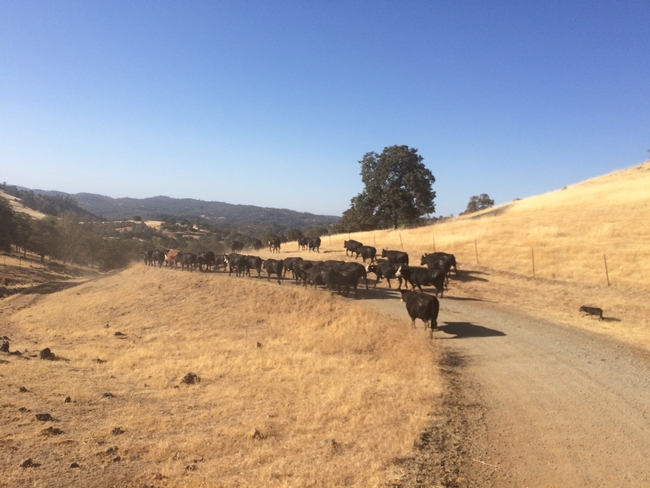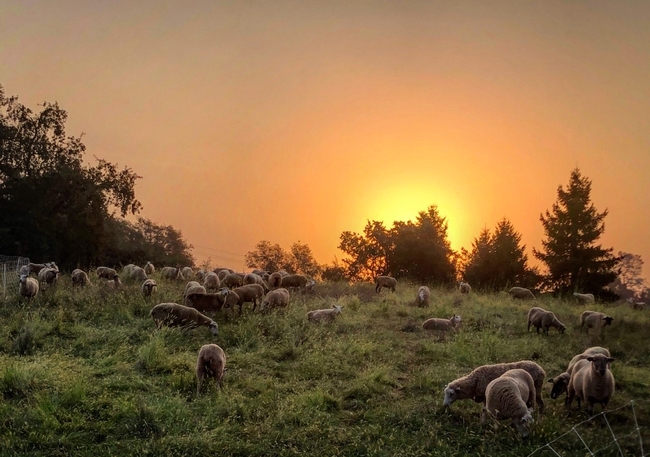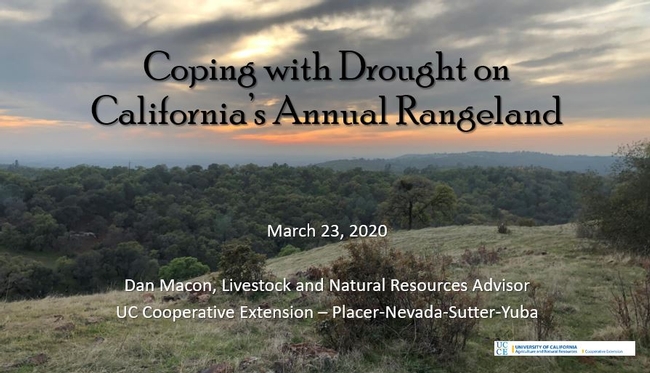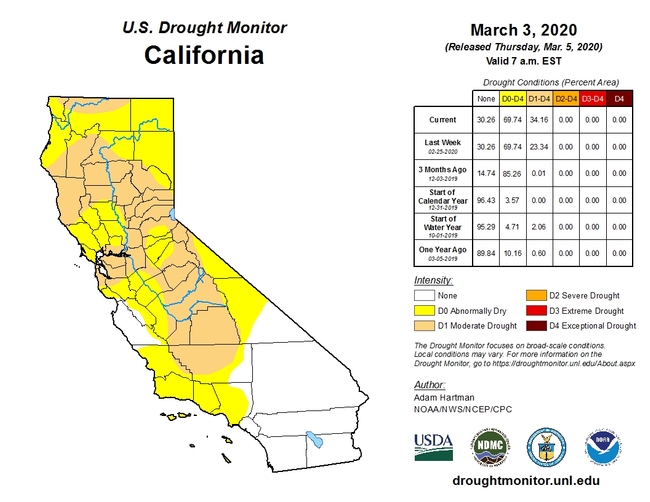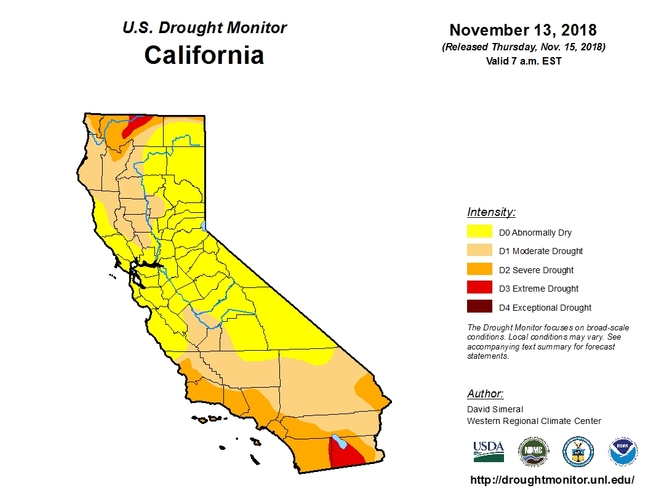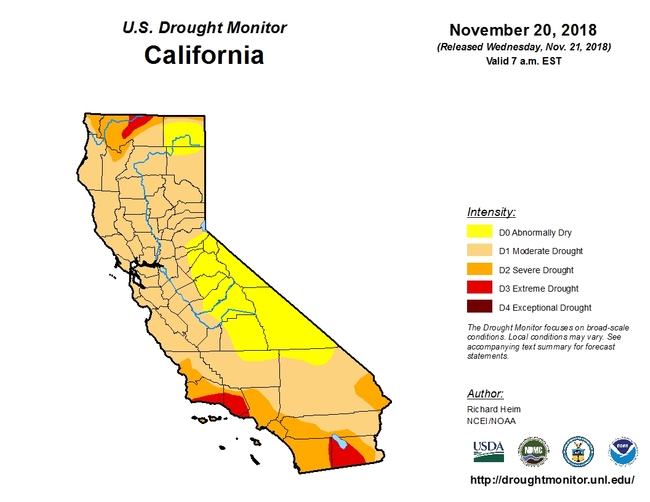- Author: Dan Macon
- Author: Grace Woodmansee
Help Us Pilot-Test a New Decision-Support Tool!
By now, most of us are well aware that we're in the second year of another significant drought. A growing proportion of Northern California is classified as D4 by the U.S. Drought Monitor. And we're coming off one of the driest rainy seasons in memory. But while many producers have already started implementing drought plans, others are still considering their options. As we learned from the 2012-2016 drought, these decisions are difficult but critical to the long-term viability of our ranches.
To this end, we've created a Drought Strategies Decision Support Tool that will help producers walk through specific strategies to deal with on-the-ground conditions. This tool will guide you through developing your forage outlook for the next 12 months. It will also help you relate your reactive strategies (like weaning your calves or lambs early or selling breeding-age females) with your ranch goals and proactive drought strategies. In addition, the tool is intended to help you establish a critical date by which you will take action. Finally, we've created some simple spreadsheets (available here) to help you analyze the costs and benefits of several key strategies (like feeding hay, weaning early, or selling livestock).
During the last drought, Glenn Nader, livestock advisor emeritus for Sutter and Yuba, said, “The only way you're gonna survive a drought is to make decisions.” We hope this tool will help you do so! But we need your help! We hope you'll use this tool to hone your own drought strategies. We also hope you'll give us feedback! How can we make this tool more useful? What are we missing?
If you'd like to set up an appointment to walk through this together, please contact us (gwoodmansee@ucanr.edu or dmacon@ucanr.edu). We're happy to go over it on the phone or schedule a ranch call. We look forward to hearing from you!
- Author: Dan Macon
Late last month, we held a Prescribed Fire on Working Landscapes workshop near Colfax, culminating in a small broadcast burn on the Edwards Family Tree Farm. As we prepared to ignite the burn, our instructor emphasized that the dry winter and early spring had resulted in fire conditions that were more like early June than late March. Last night, after I finished working in the office, I decided to try to burn some brush at our home place near Auburn. The message on the Placer County Burn Information line indicated that burning was suspended through tomorrow due to elevated fire danger. In early April. I guess it's time to start preparing our ranches for another fire season.
Wildfire preparations can more complicated for commercial livestock operations than for typical homeowners. In addition to creating a fire-safe space around homes, we also need to protect livestock and ranch infrastructure. Many ranches have livestock in multiple locations, and many of these leased pastures are simply pastures; there is no landlord or caretaker on site. Often, the number of livestock at a particular location may be more than can be easily evacuated in case of wildfire. Finally, access during a fire may be difficult due to law enforcement road blocks and priority for fire equipment. Here are a few of things we do to get ready for fire season.
Assessing the Threat
What is at risk in our operation? Do we have livestock in multiple locations? What is access like? At a minimum, our wildfire preparation efforts address the following:
- Create defensible space around home(s), barns and other infrastructure.
- Are there any access issues at any location where you have livestock? Single lane roads can be especially problematic. Do you have alternative access points?
- If you rely on dry forage for fall grazing, are there steps you can take to protect this forage from fire?
- Are there potential animal health issues associated with smoke and other indirect wildfire impacts?
Developing and Implementing a Wildfire Plan
Our ranch wildfire plan has several components:
- Protecting buildings, infrastructure and information: We remove flammable vegetation from within 100 feet of houses and other buildings. This also includes other critical infrastructure like propane tanks, wells, equipment sheds, barns and corrals. We also make sure we have protected critical legal documents and insurance information. Check CalFire's suggestions for putting together an emergency supply kit (http://www.readyforwildfire.org/Emergency-Supply-Kit/).
- Protecting forage: Like many operations, we stock our rangeland pastures conservatively to ensure a supply of fall forage. In some areas, we try to create fuel breaks to protect this forage from wildfire through targeted grazing. Disking or grading around the perimeter of pastures, or at least adjacent to potential ignition sources, can also reduce the threat. The width of any fuel break depends on the fuel type, topography/slope, and potential flame lengths that a fire might generate.
- Protecting livestock: We try to plan ahead for how we might move livestock out of harm's way in the event of a wildfire. That said, we have too many animals to evacuate on short notice; leaving animals in pasture (or “sheltering in place”) might be our best option. Fortunately, we've never had to do this. If you need to leave animals in place, be sure they have enough feed and water for several days. Will the livestock have water if the power goes out? Be sure to take down temporary fences or other hazards that may injure livestock as the fire moves through the property. Prepare for any post-fire health problems (like respiratory infections or other injuries) as well.
- Water supply: Water is critical for protecting our properties and for keeping livestock healthy. Do you have adequate water supplies for wetting down your buildings and facilities, or for directly fighting fire? If you have to pump water, do you have a backup system in case you lose power? Can you provide stock water if the power goes out? You may want to consider investing in a backup generator and/or additional water storage.
- Escape routes: Ideally, we try to have at least two routes in and out of our ranch properties. In addition, we try to think about at least two alternatives for moving livestock to safety in the event of a fire - this means loading and unloading facilities, a plan for gathering livestock, and a clear understanding of the road system near your pastures. Narrow roads can be problematic for navigating with stock trailers, especially when fire equipment is also inbound.
- Backup: Obviously, many of us can't be on hand 24 hours a day, seven days a week to respond to a fast-moving fire (especially when livestock are grazing on multiple properties). We work with friends, neighbors or colleagues to have a backup plan to evacuate or otherwise protect your livestock. Consider meeting with your neighbors to go over key livestock facilities, evacuation plans and access routes. Be sure to check in with these backup resources in the event of fire.
- Communication plans: I try to keep phone numbers for the other ranchers in our area on my phone, and I try to keep track of who runs the cows or sheep next door. During fire season, many ranchers text or call neighbors when they see smoke. Consider formalizing these calling trees.
- Situational awareness: During fire season, I constantly watch for smoke, especially when I hear fire equipment or aircraft. We carry a shovel or other fire tool and 5 gallons of water in our pickups and pay attention to where ranch visitors park – a catalytic converter on dry grass can be disastrous. I also check local news websites or alert services (like www.yubanet.com).
Writing Down our Plan
Even for ranching operations with few or no employees, writing down our plan can help others (spouses, neighbors, etc.) know what to do and who to contact in case of fire. Our written plan includes the locations where livestock are grazing (which suggests this plan needs to be updated as livestock are moved). Location information includes a physical address and/or map, along with the number and class of animals on site. We also include a description of potential evacuation routes (including locations of loading facilities). Are there safe zones (like dry lots or irrigated pastures) on the property or nearby where animals could be moved if evacuation isn't possible? Is there an onsite caretaker or neighbor we can call in case of emergency? Are there other ranchers who could help us? What are the numbers of livestock haulers who might be available? Click here for a template for completing your own plan!
I share a copy of this plan with other people in our operation – specifically, with my wife and kids, and my partner. This year, I'll plan on sharing this plan with our landlords, as well. Finally, we'll provide a copy (or at least a list of locations where we have livestock) to our local fire, animal control, and law enforcement agencies.
A Future Solution?
As with many other ranching counties in California, Placer, Nevada, and Yuba Counties have been working on formalizing an Ag Pass program designed to help ranchers gain safe access to livestock in emergency situations. Assembly Member Megan Dahle has introduced legislation (AB 1103) that would implement this program statewide. These programs would require ranchers to attend training on fire behavior and the incident command system, and would likely also require a list of properties where livestock may be grazing. If you'd like more information about the Ag Pass idea, contact me at dmacon@ucanr.edu.
As I look back over previous posts to my Ranching in the Sierra Foothills blog, I see that I seem to write about wildfire preparation just about every spring. I guess that's the nature of living with fire - our ranch fire plans are something that we should revisit every year - better to have a plan that we don't use than to need a plan when fire strikes. Stay safe this summer!
- Author: Dan Macon
As for most of you, I imagine, my world seems upside down at the moment, thanks to the COVID-19 pandemic. As I write this, my youngest daughter is finishing her junior year of high school through online courses. My oldest daughter is completing her second-to-last semester at Montana State University through online courses. And I'm working from the desk in my kitchen. I think I've participated in more video conferences in the last seven days than I've been on in my entire professional life. Based on the advice of medical professionals, we're practicing social distancing, washing our hands, and avoiding large gatherings of people.
Despite COVID-19's dominance of our news cycle and our family conversations, normal, everyday ranching concerns continue. We're at the tail end of our lambing season, which means I'm checking the flock every morning and evening (and more frequently during stormy weather). And we're still worrying about drought.
Yesterday, I was invited to give a presentation during the California-Nevada Drought Early Warning System regular bimonthly webinar. The first two talks covered current conditions and future outlook - and even with the rain and snow we had in our part of the Sierra Nevada and Sacramento Valley last week, we remain in drought conditions. If you're interested in the details, here's a recording of the webinar talks (mine is the third talk in the webinar). The first two talks confirmed my observations. After last week's rain, I checked soil moisture on our winter rangeland - even with three inches of precipitation, the soil was only 50-75 percent saturated (which explains the lack of water in our seasonal creeks). We're starting to see some of our annual grasses head out, indicating the possibility of an earlier-than-normal decline in forage quality. While the snow in the mountains was welcome, our snow water content remains well below average for this time of year.
As I was preparing my talk, I started thinking about how my approach to this year's drought was different from how we managed through 2013-14 (one of the driest years in my memory). While every drought is unique (in terms of severity, timing, and scope), I think I've also learned from my experience. In 2013, we moved our sheep to Rio Vista, where I helped manage a 1900 ewe operation. Here's a quick comparison of the steps we took in the fall of 2013 and early winter of 2014, versus our strategies in 2019-20.
2013-2014 Drought (late germination, followed by extended dry period and warm January temperatures)
- We fed our entire year's supply of alfalfa during lambing (October-December) because there was virtually no grass on our annual rangelands.
- In late January, we sold approximately one-third of our ewes to reduce our forage demand once they started to lamb.
- In mid-February, we moved our sheep back to annual rangeland in the foothills near Auburn (to ensure that the larger commercial flock would have access to rangeland in Rio Vista.
- In late February, we ultrasounded our ewes to determine whether they were pregnant. We sold a handful of open ewes.
- We weaned our lambs four weeks earlier than normal (in late May) to reduce our stocking rate and save dry forage for fall.
2019-2020 Drought (late termination, followed by wet December, dry January, record dry/warm February)
- For the first time ever, we took our ewes to alfalfa stubble in the Sacramento Valley (near Nicolaus) from mid-November until mid-December. While we incurred some additional expense, this allowed us to rest our winter rangeland for an additional 30 days.
- Because we've kept detailed grazing records since the previous drought, we were able to put together detailed, 2-month grazing plans. We identified additional forage resources on our winter rangeland that allowed us to extend our forage supplies.
- We will cull any ewe without a lamb when we ship the flock back to spring/summer pasture in April. We'll cull additional ewes at weaning (for poor mothering, bad udders, missing teeth, etc.)
I'm curious as to how your drought strategies have changed! Are you doing anything differently this year? Is this the first drought you've experienced?
- Author: Dan Macon
I've kept daily weather records since we moved to Auburn (nineteen years this week, in fact). During that time, we've experienced some exceptionally wet years (2016-17 comes to mind, when we measured almost 63 inches of precipitation), as well as some exceptionally dry years (like 2006-07, when we received just under 20 inches). Other years and specific months stand out, too - like the 14.5 inches we measured in January 2017, or the 0.5 inches we received in December 2013. Unfortunately, February 2020 will go down as one of those stand-out months - we measured a measly 0.03 inches of rain for the entire month.
The current water year (which started in October) was preceded by a wetter-than-normal September (at least here in Auburn). We received better than 2 inches - enough to germinate the grass on our annual rangelands. As often happens when we get early rain, though, we didn't get much to follow up the promising start. From October 1 through November 30, we measured just 0.71 inches. We got back on track in December (with more than 8 inches), but 2020 has been disappointing so far. Through the end of February, the season total was just 56 percent of our long-term average for the date. The March 3 version of the U.S. Drought Map puts all of Placer, Nevada, and Yuba Counties, as well as the eastern portion of Sutter County, in the Moderate Drought category. And the most recent drought outlook from the National Weather Service (see below) suggests that drought will persist or develop in the northern two-thirds of California.
Looking ahead to summer irrigation season, we're fortunate that most of our local water agencies went into the winter with more holdover in their reservoirs than normal. Even so, the latest Sierra snow pack numbers for our region are more depressing than the lack of rain. The central Sierra snow pack is only 38 percent of normal for this date.
I'm not a weather forecaster by any stretch of the imagination, but I am a weather geek. This morning, I looked at the long term average precipitation for March through June in my weather records, which didn't provide much reassurance. Even if we get 75 percent of our average rainfall for the next four months, we'll end the water year with less than 20 inches total. Even with 150 percent of average - a miracle March (and April, May, and June) - we'll end the water year well below our long-term average.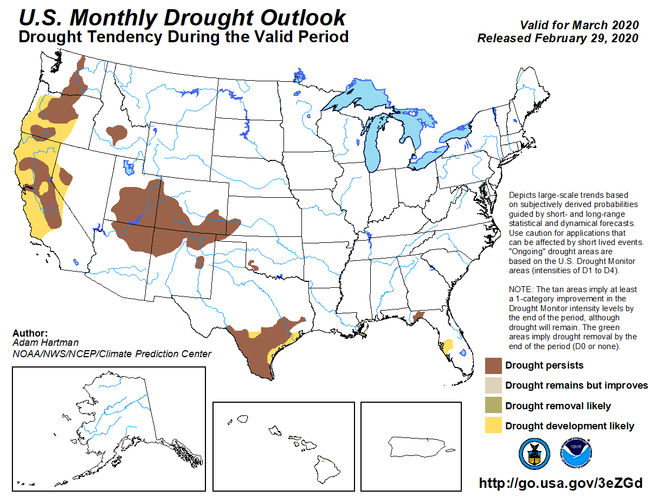
We've definitely seen an impact on the annual rangeland where we winter our sheep west of Auburn. The February 1 forage supply at the Sierra Foothill Research and Extension Center in the Yuba County foothills was about 69 percent of normal. I suspect the March 1 measurement won't be much better. While the lack of moisture is concerning, the warm February temperatures have pushed many of the blue oaks to leaf out 3-4 weeks earlier than normal. Last Thursday (before the brief storm over the weekend), I walked through one of the pastures we hadn't grazed yet. The grass was short generally, but I was especially surprised to see the vegetation beneath the oaks starting to wither and die - in the first week of March! This Sunday, after we'd received roughly a third of an inch of rain the day before, I dug a six inch hole to check soil moisture at the root zone of our annual grasses. I'd estimate moisture levels to be at around 25 percent of field capacity - in other words, incredibly dry for early March. No wonder the creeks aren't running!
Most of us will likely have enough grass to get buy this spring, although a lack of stock water could be problematic. I'm more concerned about the potential lack of fall feed. Short grass this spring means we're covering more ground with our sheep. This could mean less dry feed to return to with our sheep after the summer irrigation season ends in October. Our plan is to cull our older and less productive ewes at shearing or weaning. We may even consider selling some of the replacement ewe lambs we'd normally keep.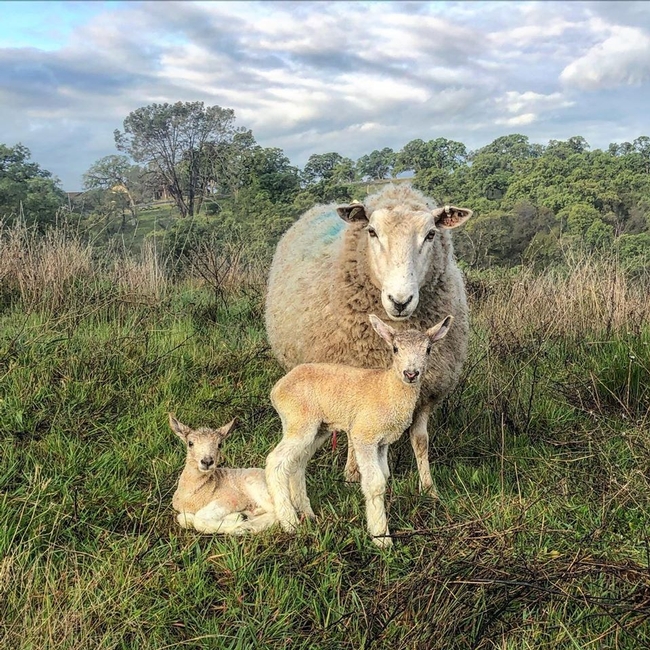
These conditions call for drastic measures, obviously - and so we've scheduled drought workshops in Grass Valley and Yuba City! Over the last six years, I've attended or helped to organize four or five drought workshops - and it's rained every time!
In all seriousness, in light of the ongoing coronavirus outbreak, we are scheduling a Drought Planning for Rangeland Livestock Producers webinar (rather than an in-person workshop) in late March or early April. Stay tuned for details! We'll share results from our 2016 post-drought rancher interviews, feature panel discussions with ranchers and other experts, and discuss ranch-specific goal setting - all focused on coping with what is shaping up to be another drought year.
If you'd like to receive notice of this webinar (and future workshops), contact me at dmacon@ucanr.edu.
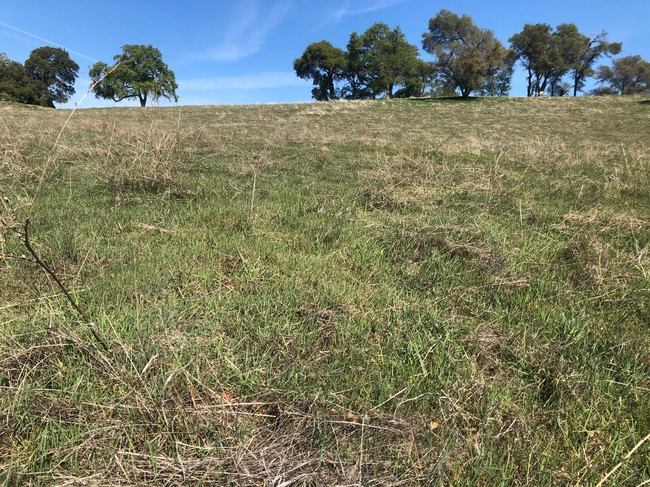
- Author: Dan Macon
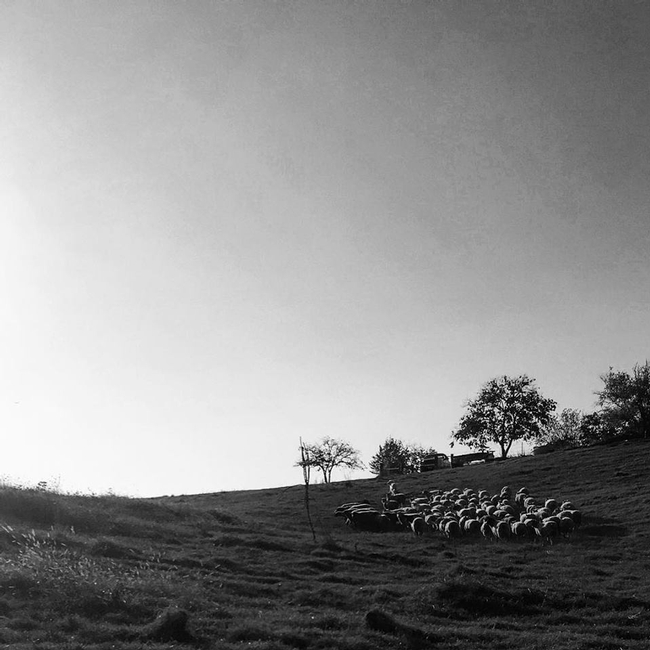
As I write this post, the first few drops of rain are falling on our part of the Sierra foothills since early October. Here in Auburn, those early autumn rains were enough to green up our annual rangeland; other parts of the foothills and Sacramento Valley weren't so fortunate. And even the areas that experienced germination have since seen most of this new grass wither in the prolonged dry period since those first storms. For some of us, the word “drought” has crept back into our vocabulary – we have a long way to go in our rainy season, but the lack of fall feed and stock water is a concern for many.
Thanks to the leadership of Dr. Leslie Roche, our UC Cooperative Extension Specialist for rangeland management at UC Davis, county range and livestock advisors and other range professionals are reporting local conditions to the U.S. Drought Monitor on a monthly basis during the fall, winter and spring. Based on local observations, formal measurements of forage production, and reports from ranchers, these monthly updates bring greater resolution – and more on-the-ground perspectives – to the U.S. Drought Monitor's weekly drought reports and longer-term drought forecasts. A comparison of last week's California drought map (top) with this week's map reflects our most recent report!
Individuals can also report on drought conditions directly! One of the easiest ways to regularly report on precipitation is to join the Community Collaborative Rain, Hail & Snow Network (COCORAHS - https://www.cocorahs.org/). I've been a member of this network for 3 or 4 years. Using the COCORAHS rain 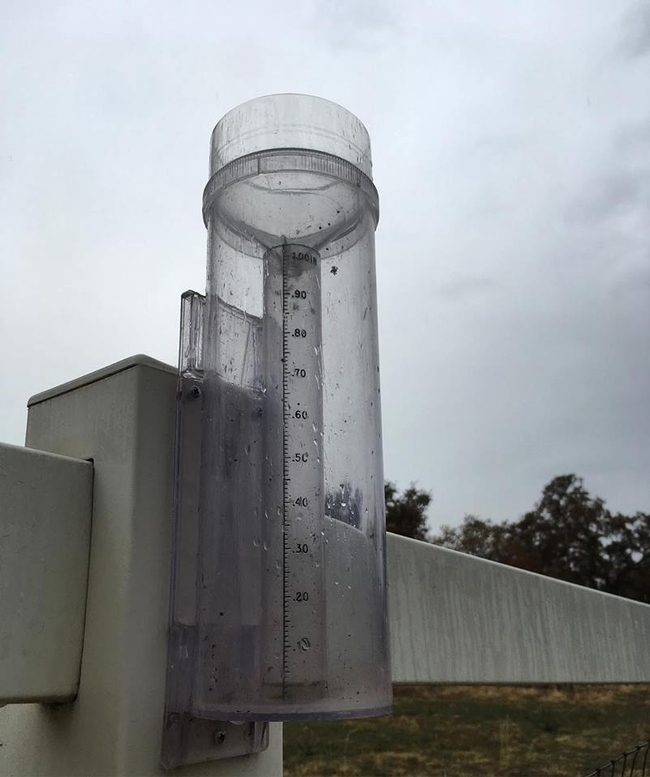
The National Drought Mitigation Center has also developed a new report form that allows users to enter site-specific conditions like precipitation, creek and spring flow, forage conditions, livestock impacts, and other drought-related effects. While our network of advisors and rangeland professionals is providing monthly input via this report, individual farmers and ranchers can also report conditions directly at https://survey123.arcgis.com/share/49e1807892e143b5b8256e0128cf3ddb.
While quantitative data is important (like precipitation amounts, pounds of forage production per acre, soil moisture and temperature, etc.), qualitative data is also critical to informing the Drought Monitor. For example, if your creeks are typically flowing by Thanksgiving, but are not flowing this year, report that fact! If you've noted that the early germinated grass has since died, report that as well! Each data point, whether quantitative or qualitative, improves the resolution of the weekly drought maps!
Finally, the UC Rangelands website has an outstanding Rangeland Drought Information Hub, with links to the Drought Impacts Reporter and Drought Monitor, weather and climate information, our Voices from the Drought audio archive, and research-based information on preparing for and responding to drought conditions. Check it out at http://rangelands.ucdavis.edu/drought/.


